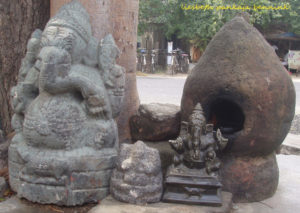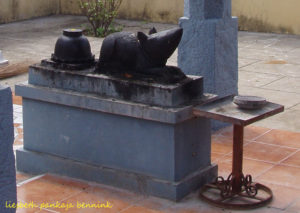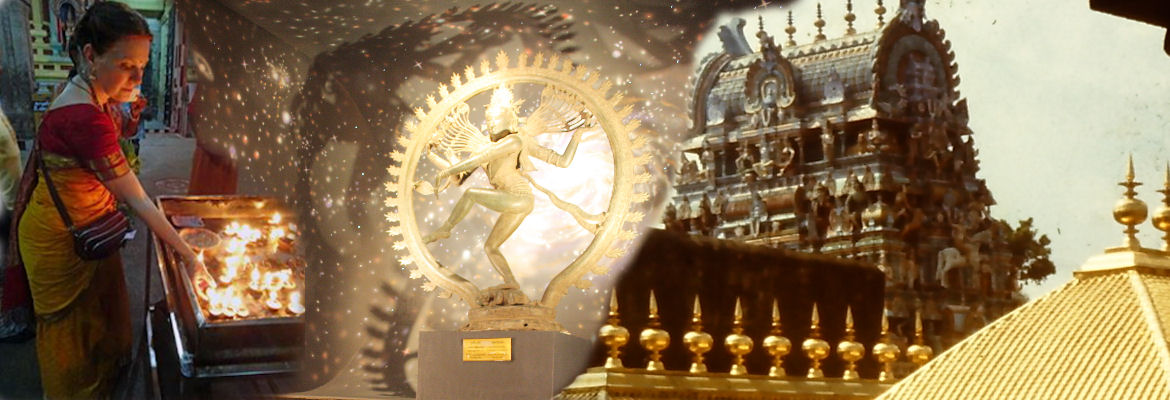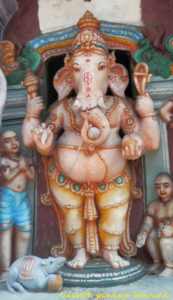On the occasion of Vinayaka Chaturthi 2016, the birthday of Lord Ganesha, Remover of Obstacles. It means the fourth day of the waxing moon in the month of Avani (Tamil), when the sun is in Simha/Leo.
Mushika vahana, modaka hasta,
Chamara Karna, Vilambita sutra,
Vamana rupa, Maheshvara putra,
Vighna Vinayaka, pada namaste.
This simple sloka tells it all. It is about Ganesha, the Lord of the Ganas, Shiva’s host; Ganapati, the general of Shiva’s armies; Vinayaka, the Remover; Vighna Vinayaka, Remover of Obstacles. The elephant headed son of Parvati and Shiva.
The mushika-shrew is his vehicle, in his hand the modaka sweet,
His ears are like the chamara, the royal yak-tail fan, his sacred thread draped beautifully over his left shoulder,
Although of a dwarf-like stature he is gigantic, Shiva’s son,
The Remover of Obstacles, his feet I salute.
Ganesha’s Birthday
It is great to see the love and enthusiasm with which Hindus all over the world celebrate Vinayaka Chaturthi, Ganesha’s birthday. This gives hope and happiness. It is also essential that these celebrations are done with right understanding of their significance. Over my forty year interaction with and love for India’s art and traditions I have come across many instances that the love and enthusiasm of the people celebrated much outdid the understanding. As a stupid outsider I always have to ask ‘why’, after ‘what’. And I was lucky enough to have several great souls in my life who shared their understanding with me. And I hope to pass it on.

Ganesha is well known, even outside the Hindu community. He is in a way a great ambassador. He is cute and cuddly, everybody loves elephants, and his chubby figure is endearing to all. What else is He? He is “mushika vahana”. The mushika is his vehicle. Now the vehicles are as it were the alter-egos of the divine powers, as they are given form and stature for us simple human beings to contemplate. The vehicle is an aspect of the deity, and expresses the persona in a different way.
Mushika, not a rat!
Now it is for reasons I didn’t understand till just right now, some sort of error has slipped into the understanding of Ganesha’s vehicle. In Northern India Ganesha’s vehicle (vahana) is nowadays depicted as a rat or a mouse. This is even stated in the wikipedia article about vahana (retrieved 5 sept 2016). And also in the wikipedia articel about Ganesha the word mushika is translated as mouse (as of 5 sept 2016) And today even in Southern India people will say the mushika is a mouse or rat. I found it in almost all articles I checked today before I started writing this post. But this is way of the mark. And this error is bound to create unnecessary confusion eventually. It shows how easy it is to loose the right significance of ancient traditions. Even for people wholeheartedly preserving their heritage.

I found out where this mistake originated. As I was checking out some thing for this post, I also checked the Sanskrit-English dictionary of the great scholar Sir Monier Williams. And on page 789 he gives as translation for the word mushika, “a rat, mouse”. No wonder everybody now thinks of the mushika as a rodent. But Sir Monier Williams is wrong in this case!
Mushika is a ferocious shrew!
But the mushika has nothing to do with a rat, mouse, or any other rodent. The mushika is a shrew. The common Asian House shrew. The shrew is a really small mammal which is kind of related to the mole. In zoology it is reckoned to belong to the family of Soricidae. It has a short and stubby tail. And a long snout which it wiggles. Almost like the trunk of an elephant. And its nature is very different. Shrews are ferocious and blood thirsty hunters. As tiny as they are they hunt mice and other animals as big as themselves, or even bigger. This video from National Geographic shows the ferociousness of the shrew.
Mushika Vahana
In depictions in South India Ganesha’s vehicle is easily recognized as a shrew. The short tail, and the upturned trunk are the mushika’s signature. In North India Ganesha is nowadays accompanied by a rodent. See the influence of a foreign scholar’s misinterpretation or mistake can have on a cultures understanding of itself!
So now you know, when you hear “mushika vahana”, it is about the shrew being Ganesha’s vehicle. Not the mouse. Now this mushika-shrew was originally a demon who was conquered by Ganesha and made into his vehicle. When you look ate a mushika-shrew closely, you can see it has a set of tiny shark-like teeth. And actually its bite is poisonous. It is a ferocious animal, which was subdued by Ganesha to become his vehicle.
Thank you for visiting, and enjoy the video. It is me rendering the sloka above as Bharata Natyam choreography. The hand gestures and body language express the words one by one.
Liesbeth Pankaja


Leave a Reply
You must be logged in to post a comment.